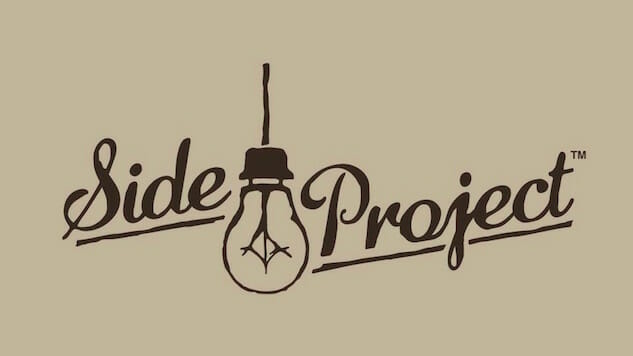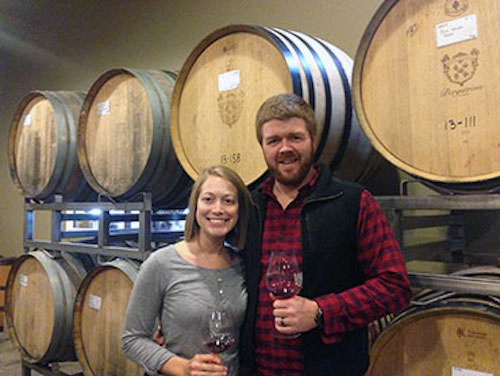
When you think about the beer scene in St. Louis, you probably think of the obvious, Anheuser Busch, but one man is quickly changing that. Cory King, the co-owner of Side Project Brewing, is leading a push to make St. Louis one of the top craft beer scenes in the country. Cory, who opened Side Project with his wife Karen over a year ago, has taken the knowledge and experience gleaned as the Head Brewer at Perennial to open Side Project, a 100% barrel-aged brewery. Right out of the gate, Cory has turned what was once a dream into one of the most unique and talked about breweries in the country. While his releases have been small, a new location is in the works, which means we can look forward to more Side Project soon. We sat down with Cory to discuss how he got here and where things are going for Side Project.

Cory and Karen King; Photo credit: Side Project Brewing
Paste: You were a homebrewer prior to Perennial, what beers/breweries inspired you to get into brewing?
Cory King: My initial leap into homebrewing actually came from my brother-in-law Brian, not a single beer or brewery. I was working fine dining and was in love with wine and contemplating the idea of starting to make wine at home when Brian introduced me to his homebrews. World-class wine comes from world-class grapes, of which I wasn’t growing, but world-class beer can come from the kitchen of a talented brewer. Our (my wife Karen and I) first all-grain batch of beer was a Belgian-style Wit that was shared with friends and family at our Engagement Party.
Paste: When you first met Phil Wymore, how confident were you that he would hire you as a head brewer at Perennial with only homebrewing experience?
CK: I was young and persistent when I first met Phil. I don’t know if the thought had ever crossed my mind that he wouldn’t hire me, I just knew that I was going to be the best candidate that he had and I was going to press hard to get the job! One thing to note is that homebrewing was a very small part of my resume. I had also had experience working for two distributors and I had managed a craft beer bar, so I presented myself as one that could help with those aspects, as well as opening a brewery.
Paste:After a year at Perennial, you were already itching to open your own place. What made you decide it was the right move to open Side Project?
CK: I have a very short attention span. Even with the wide variety of beers that Perennial brews, I was itching to brew more, and more specifically, more barrel-aged, funky beers. I don’t know if I would say that I thought it was ‘the right move’ at the time, but it kept me more inspired, more in tune with recipe formulation, more excited about this industry, which in the long run was definitely a turning point in my career.
Paste: Going from homebrewer to Head Brewer to opening your own brewery so quickly, what did it feel like when you released your first Side Project beer?
CK: It was surreal. It didn’t really soak in for a while. Jeff Cagle, a contributor for Good Beer Hunting was there taking pictures and when Michael Kiser posted the story on his website, there were a lot of comments about the faces of pure amazement that I was making that day. It was an amazing day to say the least.
Paste: Has Side Project finally cured that itch for you, or is there something next?
CK: There is something else. We are currently building out our own brewery in Maplewood, near The Cellar (Karen’s beer, wine and whiskey bar). With this brewery, we will be producing all of the Side Project beers, but I would also like to dabble in making some non barrel-aged beers. Being that Side Project only makes barrel-aged beers, this new concept will have to be a new brewery entirely.
Paste: What can you tell us about the new brewery space and perhaps when we will see it open?
CK: As mentioned, our new space is in Maplewood. With the production area, the barrel-aging building and the tasting room, we are looking at only 8000 total square feet. So still small. I never want to grow to the point where I am not the one brewing the beer. I started a brewery to be a brewer, not have a desk job. And it is still far too early to know when we will open.
Paste: Are you considering adding a partner or assistant to keep up with the demand?
CK: I am. I have a great person who is moving to St. Louis later in 2016 to help me. The help can’t come soon enough!
Paste: What position will you hold at Perennial once that new location is open?
CK: As of the start of 2016, I am actually no longer employed by Perennial. I am still brewing the Side Project beers in their facility until I get my new brewery up and running, and I am also doing a little consulting work with them. You can’t just walk away from 300 Perennial oak barrels without helping hand them off.
Paste: You’re currently on Derivation 4, do you plan to continue brewing this series or is there a stopping point?
CK: I do. The Derivations allow me to keep experimenting with Imperial Stout recipes aged in a variety of barrels. Maybe one day I will find the perfect recipe for the perfect barrel and we will grow that beer up in scale, but until then, each blend is completely unique from the last.
Paste: Will we see any of the blends reappear in the future?
CK: No. Even if I brewed the same recipe and aged it in the same type of barrels, the finished beer will still be different. If I were larger where I was blending 50 oak barrels together to homogenize the blend, then that concept would be achievable, but on my scale, I want to embrace the nuances that different vintages/blends of this beer offer.
Paste: I’ve heard from your locals about your non-carbonated stouts. Will these ever be bottled, and what has been your hesitation towards bottling them so far?
CK: They have been experiments for the locals to give us their feedback on. I love still beer, especially still stouts, but they aren’t for everyone. So before I packaged a whole batch, we wanted to see how others would respond to them. So far, they have been very well received and I might consider bottling one in the future. If that beer makes it into the hands of someone unfamiliar with my concept, they might think that a still/flat beer was an error on my production side, as opposed to what I was actually wanting. That hesitation has also been on my mind moving forward with that series of beers.
Paste: You’ve done several collaborations. If you could choose any brewery in the world to do a collaboration with (that you haven’t before) who would it be, and what would you brew?
CK: It wouldn’t be a brew; it would actually be a day of following Armand Debelder [owner and master blender of Drie Fonteinen] around, tasting, watching, listening and learning as he blended. A Side Project / Drie Fonteinen special blend would be the pinnacle of my brewing life!
Paste: What’s your favorite beer you’ve brewed?
CK: Favorites are always a product of the time and moment at which you are drinking. Most days, I want, light, airy, tart, subtle and purposeful. Our soon to be released Tête de Cuvée is a blend of my finest Saisons I have produced so far. The overall blend is one of those beers that I wish I could have every day. But right now as I’m sitting here, it’s 16 degrees outside and a big stout sounds about perfect and my favorite one of those I have brewed is our Double Barrel Derivation. Sometimes barrels just elevate to another level and rarely do they become perfect, but this was one of those situations. It was aged in Willet 12 year bourbon barrels for two years and then finished in Port barrels for another three months. It’s my favorite stout I have ever brewed or had the pleasure of drinking.
Paste: Does DB Derivation use a blend that was used for any of the previous releases, or was it an entirely different blend? Any plans to release it?
CK: DB Derivation was a base recipe that I hadn’t used in any of my other blends yet. My base imperial stout recipes have very normal names (oats, rye, wheat, munich, ellipses). DB Derivation was the ellipses recipe in 12 year Willet bourbon barrels. I have used Willet barrels before (two year rye, 11 year bourbon) but this is the first 12 year bourbon from them.
Yes, it will be released at some point, just trying to figure out how we are going to do that one—on site only, raffle, or surprise.
Paste: If you could change one thing about craft beer today, what would it be?
CK: As for something I would like to change, I wish that we had more self-governing in our industry. What I mean is that with the huge growth we are experiencing, there are people entering the brewing industry and trying to cut corners wherever possible. I make a lot of “wild” ales with actual wild yeast and bacteria from Missouri. It took me years to harness their capabilities and years to produce quality, wild beers. Newcomers open up a brewery, buy a Brett strain from the lab and slap “Wild Ale” on the label and then charge a premium for that beer. If we become more focused on verbiage and marketing than education and transparency, we are no better than the breweries in which we are stealing market share from.